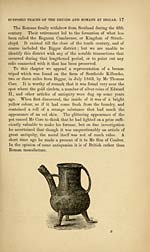Biggar and the House of Fleming
(34) Page 16
Download files
Complete book:
Individual page:
Thumbnail gallery: Grid view | List view

16 BIGGAR AND THE HOUSE OF FLEMING.
traces of it were at that time distinctly to be seen in Westraw
Moss, west of the town. This road or causeway is referred to
so late as 1765, in the Kecords of the Baron Bailie's Court of
Biggar, when a complaint of Robert Wilson, ' tacksman of ye
grass of Westraw Moss, above ye cassaw leading through ye
said moss,' was lodged against certain feuars in Westraw for
cutting ' Roughheads,' and pasturing their cattle on parts of
the moss, to which, it was alleged, they had no right. This
' cassaw ' gave the name of ' Causeyend ' to a small hamlet
built at its western extremity, and some of the houses of
which still exist. This causeway was, however, in all likeli-
hood, of comparatively modern formation. The workmen,
while engaged some years ago in making excavations in this
moss for the line of the Symington, Biggar, and Broughton
Railway, came upon a causeway of stones, about three feet
below the surface, which had evidently been formed at an
early period, and which, in all probability, was part of the
Watling Street of the Romans. It was minutely examined by
several gentlemen in the neighbourhood, and, from the syste-
matic and skilful arrangement of the stones, no doubt was left
on their minds that they had been placed there for the pur-
pose of forming a road. By this Iter, then, most of the
Roman troops would pass and repass on their marches to sub-
due, or, as Claudian says, 'to bridle the fierce Scots.' The
probability, therefore, is, that Agricola, Hadrian, Urbicus,
Calphurnius Agricola, Marcellus, Severus, Theodosius, and
other commanders of the successive invading armies, halted at
Biggar, and marshalled their legions on the adjoining plains.
Along the great Roman Iter, on each side of the valley of
the river Clyde, circular earthen works are to be seen on the
summits of the more isolated hills, and are supposed to be the
strongholds of the early inhabitants. No less than eight or
nine of these primitive fortifications are to be found in the
parish of Coulter, and traces of them are to be seen on several
of the Biggar hills, particularly one distinctly marked on Bizzy-
berry, immediately above the town.*
* For a most learned and elaborate account of the ancient camps and Roman
roads in the Upper Ward of Lanarkshire we refer to the recently published
work entitled "The Upper Ward of Lanarkshire, described and delineated,"
by George Vere Irving, Esq., and Alexander Murray, Esq.
traces of it were at that time distinctly to be seen in Westraw
Moss, west of the town. This road or causeway is referred to
so late as 1765, in the Kecords of the Baron Bailie's Court of
Biggar, when a complaint of Robert Wilson, ' tacksman of ye
grass of Westraw Moss, above ye cassaw leading through ye
said moss,' was lodged against certain feuars in Westraw for
cutting ' Roughheads,' and pasturing their cattle on parts of
the moss, to which, it was alleged, they had no right. This
' cassaw ' gave the name of ' Causeyend ' to a small hamlet
built at its western extremity, and some of the houses of
which still exist. This causeway was, however, in all likeli-
hood, of comparatively modern formation. The workmen,
while engaged some years ago in making excavations in this
moss for the line of the Symington, Biggar, and Broughton
Railway, came upon a causeway of stones, about three feet
below the surface, which had evidently been formed at an
early period, and which, in all probability, was part of the
Watling Street of the Romans. It was minutely examined by
several gentlemen in the neighbourhood, and, from the syste-
matic and skilful arrangement of the stones, no doubt was left
on their minds that they had been placed there for the pur-
pose of forming a road. By this Iter, then, most of the
Roman troops would pass and repass on their marches to sub-
due, or, as Claudian says, 'to bridle the fierce Scots.' The
probability, therefore, is, that Agricola, Hadrian, Urbicus,
Calphurnius Agricola, Marcellus, Severus, Theodosius, and
other commanders of the successive invading armies, halted at
Biggar, and marshalled their legions on the adjoining plains.
Along the great Roman Iter, on each side of the valley of
the river Clyde, circular earthen works are to be seen on the
summits of the more isolated hills, and are supposed to be the
strongholds of the early inhabitants. No less than eight or
nine of these primitive fortifications are to be found in the
parish of Coulter, and traces of them are to be seen on several
of the Biggar hills, particularly one distinctly marked on Bizzy-
berry, immediately above the town.*
* For a most learned and elaborate account of the ancient camps and Roman
roads in the Upper Ward of Lanarkshire we refer to the recently published
work entitled "The Upper Ward of Lanarkshire, described and delineated,"
by George Vere Irving, Esq., and Alexander Murray, Esq.
Set display mode to:
![]() Universal Viewer |
Universal Viewer | ![]() Mirador |
Large image | Transcription
Mirador |
Large image | Transcription
Images and transcriptions on this page, including medium image downloads, may be used under the Creative Commons Attribution 4.0 International Licence unless otherwise stated. ![]()
| Histories of Scottish families > Biggar and the House of Fleming > (34) Page 16 |
|---|
| Permanent URL | https://digital.nls.uk/94839690 |
|---|
| Description | A selection of almost 400 printed items relating to the history of Scottish families, mostly dating from the 19th and early 20th centuries. Includes memoirs, genealogies and clan histories, with a few produced by emigrant families. The earliest family history goes back to AD 916. |
|---|

